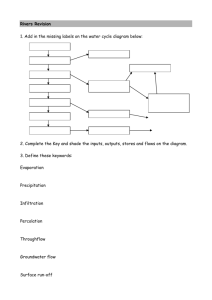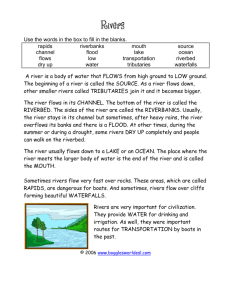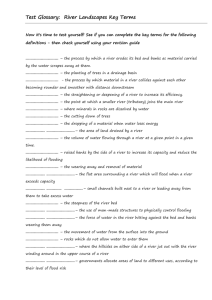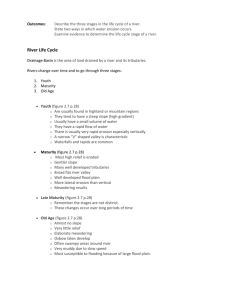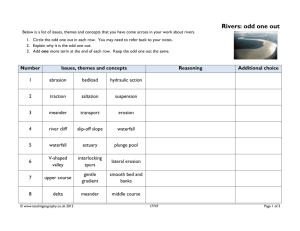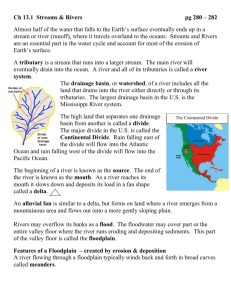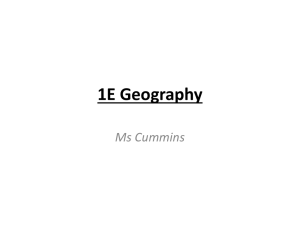Physical Environments Rivers Revision
advertisement
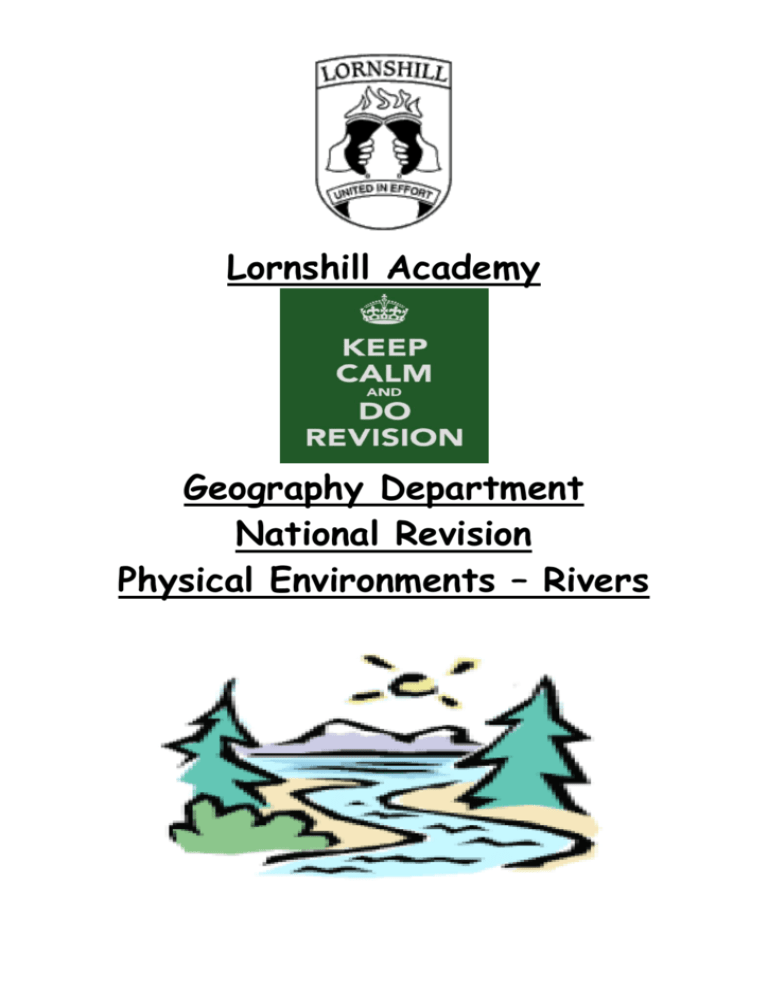
Lornshill Academy Geography Department National Revision Physical Environments – Rivers Revision Notes for Rivers What you need to know: 1. 2. 3. 4. 5. 6. How rivers erode, transport and deposit. The Upper Course: Formation of a V-shaped valley and a Waterfall The Middle Course: Formation of a Meander The Lower Course: Formation of an Ox Bow Lake, Flood Plain & Levees River map work How people use river landscapes Rivers are one part of the global water cycle – returning water from the mountains to the sea. The area around the river is called the Drainage basin. It is given this name because any rain which falls within this area drains into that river. 1. Erosion, Transportation & Deposition Processes of River Erosion: o Hydraulic Action: The sheer force of the water hitting the river banks and flowing over the river bed and wearing down the rock. o Corrasion: The banks are eroded by the rocks the river carries. These act like sandpaper, scraping and smoothing the banks as they move past. The river bed is eroded by the larger rocks bouncing along and hitting the rock underneath until it breaks. o Attrition: This is where the rivers load hits and rubs against each other, and also the river bed and banks. This makes the particles smaller and more rounded. Processes of Transportation: o Traction: Rolling stones along the river bed. This requires lots of energy. o Suspension: Clay sized particles are carried along by the river flow. o Saltation: Sand sized particles bounce along the river bed. o Solution: Some minerals are dissolved by the river water. Deposition occurs when the river loses energy and/or the river has too much load. One way of thinking about rivers is to divide their journey up into three sections: o Upper Course o Middle Course o Lower Course Course Main Activity Main Features Source, tributaries, V- Upper Course (steep gradient) Vertical (downward erosion) shaped valley, interlocking spurs, waterfalls, gorges, rapids. Middle Course (gentle Lateral (sideways) erosion Meanders, River Beaches, gradient) starts, transportation River Cliffs. Lower Course (very low gradient) Deposition 2. Landforms often found in a River’s Upper Course: a) V-shaped Valleys: Floodplains, Ox Bow lakes, levees, estuary o Rivers begin high up in the mountains so they flow quickly downhill eroding the landscape vertically. o The river cuts a deep notch down into the landscape using hydraulic action and corrosion. o As the river erodes downwards, some of the rocks fall into the river and this helps the process of corrosion, leading to further erosion. o The river transports the rocks downstream and the channel becomes wider and deeper creating a V-shaped valley between interlocking spurs. b) Waterfalls: o The river flows over bands of softer and harder rocks. o Softer rock is more quickly eroded. The river undercuts the harder rock leaving an overhang. o The river forms a plunge below the waterfall. o Overhanging rock is unsupported and falls into the plunge pool. o o The waterfall moves upstream. o This process continues and a gorge is cut back into the hillside. 3. River Landforms often found in the Middle Course: Meanders: The bends in a river are called ‘meanders’. Once formed they get more and more ‘bendy’ because the water is forced to go faster around the outside bend. This causes erosion and makes the river deeper here. The riverbed at the outside bend gets undercut and a river cliff forms. On the inside bend, the river is flowing more slowly. This causes it to deposit (or drop) some of the material it was carrying. This makes it shallower on the inside bend – forming what is called a river beach (or slip-off slope). 4. River Landforms often found in the Lower Course: a) Ox-bow Lakes: These form when a meander gets very ‘bendy’ (diagram 1). As this continues the neck between meanders gets narrower and narrower (diagram 2). Eventually during a flood the river cuts across the meander neck (diagram 3) eroding a new channel. Over time the old meander loop becomes detached from the river by the river depositing material (diagram 4). This is called an ox-bow lake – and it will eventually dry up and disappear. b) Flood Plains: When a river floods it leaves behind fine silt (called alluvium). This can flatten and smooth out any small bumps in the landscape. The flat land next to a river is called a flood plain. It is shown on an OS map by white space (i.e. no contour lines) next to a river. c) Leveés: As soon as the river overflows the river channel and ‘bursts its banks’, the water goes from being in the deep river channel to suddenly spreading out over the flood plain. This causes an increase in friction that can result in bigger stones being deposited here. These can build up into natural embankments either side of the river channel – called levees. On an OS map they are shown by small black triangles next to the river. o o The river is on its floodplain with a very low gradient. The river is mainly depositing (silt and sand). o When the river floods a lot of silt is deposited on the river banks and much less on the floodplain. o Frequent flooding continues this build up. o When the river is flowing normally it deposits in the river bed. o This raises the river above the floodplain. o Usually the built-up levées protect the plain from flooding. 5. River Map Work V-shaped valleys: On an OS map, Vshaped valleys are shown by the contour lines bending in a ‘V’ around the river: Waterfalls: Where there is a waterfall on an OS map, the word ‘waterfall’ will be written in blue writing. 6. How do people use River Landscapes? Over the course of a river, from mountains to the sea, there are many ways that people use the land. For example: Farming In the Upper Course there are often hill-sheep farms and as we get nearer to the lower course the type of farming change to being more arable. On the flood plains of the river in the lower course, the type of farming is often pastoral – keeping animals like cows or pigs. These like the grass that grows well on a river flood plain, and they can be easily moved to safety if the river floods. Forestry On the steeper slopes of the Upper Course of rivers, forestry is a good way of using the land. Trees grow well on the steeper slopes and this is a way of using land that is difficult to use for anything else. Hydroelectric Power and Reservoirs Rivers can provide clean and renewable energy in the form of hydroelectric power in the upper course. Dams can also be built to create reservoirs, which supply our towns and cities with water. Recreation and Tourism Rivers are used for various recreational pursuits: Upper Course- white-water rafting, gorge walking, sightseeing eg waterfalls. Middle and Lower Courses- Gentler slopes and good access via roads and railways to both lower and upper course features means lots of tourists stay here in B&Bs (often provided by farmers) and caravan and campsites.


